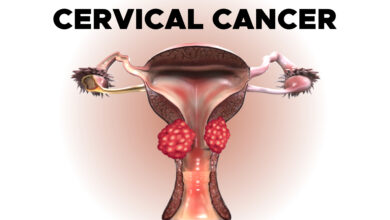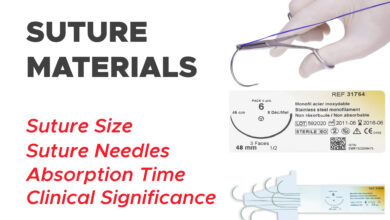
The ideal suture material – is sterile, easy to handle, strong (along all of its length), resistant to infection, and cheap. It also has to behave in the way we want it to, in a consistent manner.
As you might imagine, it is extremely difficult to manufacture the ‘perfect’ suture material, which is why there is a wide variety of suture materials available which offer unique characteristics.
Suture Materials are split into the following categories:
- Natural vs. Synthetic
- Absorbable vs. Non-Absorbable
- Braided vs. Non-Braided
When we use a suture material in the human body we are implanting a foreign tissue into a host. It follows on, therefore, that a tissue reaction within the host should be expected, and can be either an advantage or a disadvantage.
Sutures are used by your doctor to close wounds to your skin or other tissues. When your doctor sutures a wound, they’ll use a needle attached to a length of “thread” to stitch the wound shut.
There are a variety of available materials that can be used for suturing. Your doctor will choose a material that’s appropriate for the wound or procedure.
Types of sutures
The different types of sutures can be classified in many ways.
First, suture material can be classified as either absorbable or nonabsorbable.
Absorbable sutures don’t require your doctor to remove them. This is because enzymes found in the tissues of your body naturally digest them.
Nonabsorbable sutures will need to be removed by your doctor at a later date or in some cases left in permanently.

Second, the suture material can be classified according to the actual structure of the material. Monofilament sutures consist of a single thread. This allows the suture to more easily pass through tissues. Braided sutures consist of several small threads braided together. This can lead to better security, but at the cost of an increased potential for infection.
Third, sutures can be classified as either being made from natural or synthetic material. However, since all suture material is sterilized, this distinction is not particularly useful.
Types of absorbable sutures
Absorbable sutures are broken down by the body via enzymatic reactions or hydrolysis. The time in which this absorption takes place varies between material, location of suture, and patient factors.
For the more commonly used absorbable sutures, complete absorption times will vary:
- Vicryl rapide = 42 days
- Vicryl = 60 days
- Monocryl = ~100 days
- PDS = ~200 days
Gut– This natural monofilament suture is used for repairing internal soft tissue wounds or lacerations. The gut shouldn’t be used for cardiovascular or neurological procedures. The body has the strongest reaction to this suture and will often scar over. It’s not commonly used outside of gynecological surgery.
- Do people really use catgut?– Naturally occurring suture materials (g. catgut, silk, steel, etc.) are not as commonly used as they once were. Catgut is a good suture material made by twisting together strands of bovine intestine collagen. It boasts excellent handling properties but is now banned in Europe and Japan due to the risk of disease transmission including bovine spongiform encephalopathy (mad-cow disease).
Polydioxanone (PDS) – This synthetic monofilament suture can be used for many types of soft tissue wound repair (such as abdominal closures) as well as for pediatric cardiac procedures.
Poliglecaprone (MONOCRYL) – This synthetic monofilament suture is used for general use in soft tissue repair. This material shouldn’t be used for cardiovascular or neurological procedures. This suture is most commonly used to close the skin in an invisible manner.
Polyglactin (Vicryl) – This synthetic braided suture is good for repairing hand or facial lacerations. It shouldn’t be used for cardiovascular or neurological procedures.
Types of nonabsorbable sutures
Non-absorbable sutures are used to provide long-term tissue support, remaining walled-off by the body’s inflammatory processes (until removed manually if required).

Uses include tissues that heal slowly, such as fascia or tendons, closure of abdominal wall, or vascular anastomoses.
Some examples of nonabsorbable sutures can be found below. These types of sutures can all be used generally for soft tissue repair, including for both cardiovascular and neurological procedures.
Nylon– A natural monofilament suture.
Polypropylene (Prolene) – A synthetic monofilament suture.
Silk– A braided natural suture. Silk was used for a wide variety of uses before the introduction of synthetic materials. It is, however, still used to secure surgical drains.
Polyester (Ethibond) – A braided synthetic suture.
Steel– is a sterile suture that can be monofilament or polyfilament. It is still commonly used in orthopedics for cerclage and tendon repairs, but also in the closure of the sternum (spotted on a chest X-Ray).
Monofilament vs Multifilament
Suture materials can also be sub-classified by their structure:
Monofilament suture – a single stranded filament suture (e.g nylon, PDS, or prolene). They have a lower infection risk but also have poor knot security and ease of handling.
Multifilament suture – made of several filaments that are twisted together (e.g braided silk or vicryl). They handle easier and hold their shape for good knot security, yet can harbour infections.
Does Size Matter?
The tensile strength and handling properties are affected by the thickness of the suture thread. Suture materials are therefore manufactured in a variety of sizes. The size (4-0, 3-0, etc.) describes the diameter of the suture strand.
It is important to note that the larger the number prefix, the smaller the diameter of the thread. For example, 7-0 commonly used for facial lacerations in plastic surgery is much finer than 1-0 or 0, commonly used to close a midline laparotomy.

So, you’ve chosen your suture material. All that is left is working on your technique and not giving yourself a needlestick injury.
Surgical Needles
The surgical needle allows the placement of the suture within the tissue, carrying the material through with minimal residual trauma.
The ideal surgical needle should be rigid enough to resist distortion, yet flexible enough to bend before breaking, be as slim as possible to minimize trauma, sharp enough to penetrate tissue with minimal resistance, and be stable within a needle holder to permit accurate placement.
Commonly, surgical needles are made from stainless steel.
They are composed of: The swaged end connects the needle to the suture
The needle body or shaft is the region grasped by the needle holder. Needle bodies can be round, cutting, or reverse cutting:

- Round bodied needles are used in friable tissue such as liver and kidney
- Cutting needles are triangular in shape, and have 3 cutting edges to penetrate tough tissue such as the skin and sternum, and have a cutting surface on the concave edge
- Reverse cutting needles have a cutting surface on the convex edge, and are ideal for tough tissue such as tendon or subcuticular sutures, and have a reduced risk of cutting through tissue
The needle point acts to pierce the tissue, beginning at the maximal point of the body and running to the end of the needle, and can be either sharp or blunt:
- Blunt needles are used for abdominal wall closure, and in friable tissue, and can potentially reduce the risk of blood borne virus infection from needlestick injuries.
- Sharp needles pierce and spread tissues with minimal cutting, and are used in areas where leakage must be prevented.
The needle shape varies in their curvature and is described as the proportion of a circle completed – the ¼, ⅜, ½, and ⅝ are the most common curvatures used. Different curvatures are required depending on the access to the area to suture.




Many thanks, wondering in case of facial skin closure (particularly when you remove skin cancer…), if you use an absorbable suture to close the derm first prior to place nylon sutures or you only close the skin with nylon?
Best wishes
Sir, may I know the medicine that can destroy stitch without cut